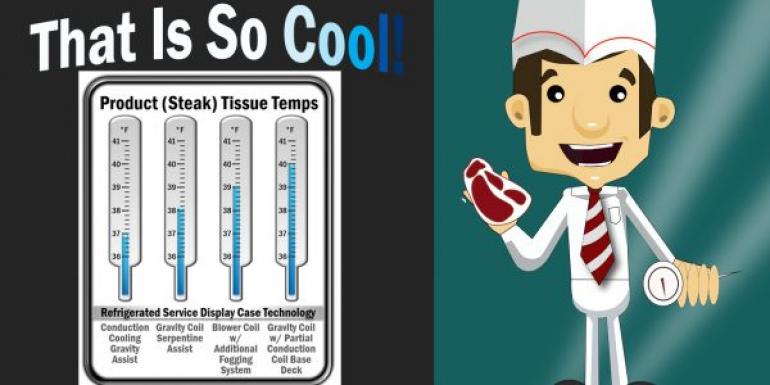That’s So Cool…Literally!

hillphoenix.com
In the world of refrigerated service display cases, “cool” is the name of the game. And there is no place where this is more important than the sale of fresh meat, poultry and seafood products. Keeping these products at the proper temperature can affect everything from shelf life and product integrity to the very safety of the food itself. Obviously, for a food retailer, the impact of this on store profit can be costly.
Although there are a number of variables that affect the shelf life and product integrity of these perishable foods, the tissue temperature of the product itself is arguably the single most determining factor. The growth rate of microorganisms (e.g., bacteria) on the product’s surface can change dramatically with very small changes in tissue temperature. This “microbial load” affects everything from product tissue discoloration to rate of product spoilage. The criticality of proper temperature control is perhaps best summed up by an article in the journal, Meat Science, titled “Extending the Storage Life of Raw, Chilled Meats” where the author, C.O. Gill, states, “Although the rates of growth of different species of spoilage bacteria differ considerably, the rates of all increase rapidly with small increases in temperature above the optimum for storage of chilled meat.”
All of this begs the all-important question, “Just which refrigerated service display case is best when it comes to keeping the tissue temperature of fresh meat, poultry, and seafood at the optimum level?” A recent research work, “Evaluation of Shelf Life and Quality of Beef Steaks and Chicken Breasts in Refrigerated Display Cases Using Four Unique Cooling Technologies”, fully accepted and published in the journal Food Control, set out to find the answer to that and other questions related to shelf life and product integrity. The study compared four different refrigerated service display case technologies, each utilizing either convective, conductive, or a combination of the two cooling methods, to determine the effect that each had on product shelf life and microorganism growth on beefsteak and chicken breasts. The four technologies studied were:
- Conduction Cooling Gravity Assist Service Case (CCGA)
- Gravity Coil Service Case with Partial Conduction Coil Base Deck (PCC)
- Gravity Coil Service Case with Serpentine Assist (GSA)
- Blower Coil Service Case with an Additional Fogging System (BCF)
Among the notable differences between the four case technologies studied in areas that would most directly impact product integrity and meat quality were:
- Internal beefsteak meat (product tissue) temperature varied between 36.95 °F and 39.90 °F (2.75 °C and 4.39 °C) with the lowest temperature reading belonging to the conductive cooling CCGA case while the warmest tissue temperatures tended to occur when the cuts were placed in the PCC (Gravity Coil Service Case with Partial Conduction Coil Base Deck) case. The chicken breasts mirrored these results.
- Product weight loss (shrinkage) was notably lower in the CCGA conductive cooling case than in the other three display case technologies evaluated.
The Conduction Cooling Gravity Assist Service Case (CCGA) technology did maintain the lowest internal product tissue temperature of the beefsteaks and chicken breasts compared to the other cooling systems even during compromised cooling conditions such as doors left open during peak summer months. This is driven in large part by the fact that the CCGA’s conductively-cooled design creates a “microclimate”4 at the product’s surface which keeps the temperature at the proper level while elevating the relative humidity to minimize any moisture losses in the product tissue. A “microclimate” is defined as the climate in a small, specific place in an area as contrasted with the climate of the entire area.
The Food Control study concluded that the Conduction Cooling Gravity Assist Service Case (CCGA) utilizing pulse-flow coolant control was superior to the other three technologies studied in its ability to create a favorable climate for the product integrity and safety of meat products. The CCGA case used in the study was the Hillphoenix SSGC Coolgenix refrigerated merchandiser.
So, keep it cool — or better yet — keep it properly cool by using Hillphoenix Coolgenix display cases for your fresh meat, poultry and seafood product merchandising needs. You’ll see just what a difference a few degrees can make!
by Margie Proctor – Hillphoenix
